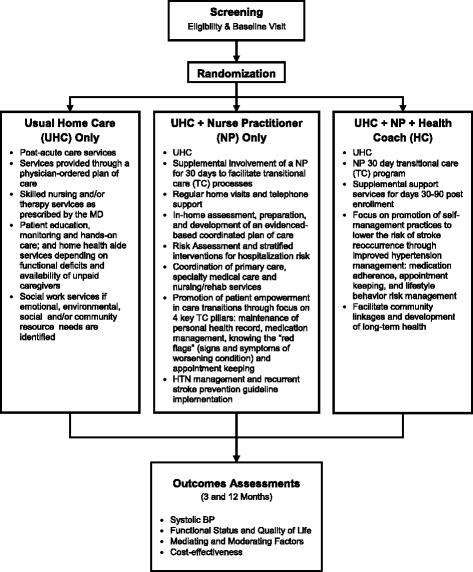Center for stroke disparities solutions community- based care transition interventions: study protocol of a randomized controlled trial
- PMID: 25622823
- PMCID: PMC4322449
- DOI: 10.1186/s13063-015-0550-3
Center for stroke disparities solutions community- based care transition interventions: study protocol of a randomized controlled trial
Abstract
Background: Racial and ethnic disparities persist in stroke occurrence, recurrence, morbidity and mortality. Uncontrolled hypertension (HTN) is the most important modifiable risk factor for stroke risk. Home health care organizations care for many patients with uncontrolled HTN and history of stroke; however, recurrent stroke prevention has not been a home care priority. We are conducting a randomized controlled trial (RCT) to compare the effectiveness, relative to usual home care (UHC), of two Community Transitions Interventions (CTIs). The CTIs aim to reduce recurrent stroke risk among post-stroke patients via home-based transitional care focused on better HTN management.
Methods/design: This 3-arm trial will randomly assign 495 black and Hispanic post-stroke home care patients with uncontrolled systolic blood pressure (SBP) to one of three arms: UHC, UHC complemented by nurse practitioner-delivered transitional care (UHC + NP) or UHC complemented by an NP plus health coach (UHC + NP + HC). Both intervention arms emphasize: 1) linking patients to continuous, responsive preventive and primary care, 2) increasing patients'/caregivers' ability to manage a culturally and individually tailored BP reduction plan, and 3) facilitating the patient's reintegration into the community after home health care discharge. The primary hypothesis is that both NP-only and NP + HC transitional care will be more effective than UHC alone in achieving a SBP reduction. The primary outcome is change in SPB at 3 and 12 months. The study also will examine cost-effectiveness, quality of life and moderators (for example, race/ethnicity) and mediators (for example, changes in health behaviors) that may affect treatment outcomes. All outcome data are collected by staff blinded to group assignment.
Discussion: This study targets care gaps affecting a particularly vulnerable black/Hispanic population characterized by persistent stroke disparities. It focuses on care transitions, a juncture when patients are particularly susceptible to adverse events. The CTI is innovative in adapting for stroke patients an established transitional care model shown to be effective for HF patients, pairing the professional NP with a HC, implementing a culturally tailored intervention, and placing primary emphasis on longer-term risk factor reduction and community reintegration rather than shorter-term transitional care outcomes.
Trial registration: ClinicalTrials.gov NCT01918891 ; Registered 5 August 2013.
Figures
Similar articles
-
Reducing Hypertension in a Poststroke Black and Hispanic Home Care Population: Results of a Pragmatic Randomized Controlled Trial.Am J Hypertens. 2020 Apr 1;33(4):362-370. doi: 10.1093/ajh/hpz148. Am J Hypertens. 2020. PMID: 31541606 Free PMC article. Clinical Trial.
-
Comparative effectiveness of home blood pressure telemonitoring (HBPTM) plus nurse case management versus HBPTM alone among Black and Hispanic stroke survivors: study protocol for a randomized controlled trial.Trials. 2015 Mar 15;16:97. doi: 10.1186/s13063-015-0605-5. Trials. 2015. PMID: 25873044 Free PMC article. Clinical Trial.
-
Effect of Nurse Practitioner Interventions on Hospitalizations in the Community Transitions Intervention Trial.Nurs Res. 2021 Jul-Aug 01;70(4):266-272. doi: 10.1097/NNR.0000000000000508. Nurs Res. 2021. PMID: 34160182 Free PMC article. Clinical Trial.
-
Effect of a Coordinated Community and Chronic Care Model Team Intervention vs Usual Care on Systolic Blood Pressure in Patients With Stroke or Transient Ischemic Attack: The SUCCEED Randomized Clinical Trial.JAMA Netw Open. 2021 Feb 1;4(2):e2036227. doi: 10.1001/jamanetworkopen.2020.36227. JAMA Netw Open. 2021. PMID: 33587132 Free PMC article. Clinical Trial.
-
A novel community-based study to address disparities in hypertension and colorectal cancer: a study protocol for a randomized control trial.Trials. 2013 Sep 8;14:287. doi: 10.1186/1745-6215-14-287. Trials. 2013. PMID: 24011142 Free PMC article. Clinical Trial.
Cited by
-
[Experiences of Transitional Care for Medicaid Case Managers].J Korean Acad Nurs. 2023 Oct;53(5):556-569. doi: 10.4040/jkan.23031. J Korean Acad Nurs. 2023. PMID: 37977565 Korean.
-
Interventions for improving modifiable risk factor control in the secondary prevention of stroke.Cochrane Database Syst Rev. 2018 May 7;5(5):CD009103. doi: 10.1002/14651858.CD009103.pub3. Cochrane Database Syst Rev. 2018. PMID: 29734470 Free PMC article.
-
Stroke Disparities: From Observations to Actions: Inaugural Edward J. Kenton Lecture 2020.Stroke. 2020 Nov;51(11):3392-3405. doi: 10.1161/STROKEAHA.120.030428. Epub 2020 Oct 26. Stroke. 2020. PMID: 33104468 Free PMC article.
-
Pain and Function in Home Care: A Need for Treatment Tailoring to Reduce Disparities?Clin J Pain. 2017 Apr;33(4):300-309. doi: 10.1097/AJP.0000000000000410. Clin J Pain. 2017. PMID: 27518494 Free PMC article.
-
Black/Hispanic Disparities in a Vulnerable Post-Stroke Home Care Population.J Racial Ethn Health Disparities. 2019 Jun;6(3):525-535. doi: 10.1007/s40615-018-00551-y. Epub 2018 Dec 17. J Racial Ethn Health Disparities. 2019. PMID: 30560319 Free PMC article.
References
-
- Lackland DT, Roccella EJ, Deutsch AF, Fornage M, George MG, Howard G, et al. Factors influencing the decline in stroke mortality: a statement from the American Heart Association/American Stroke Association. Stroke. 2014;45:315–53. doi: 10.1161/01.str.0000437068.30550.cf. - DOI - PMC - PubMed
Publication types
MeSH terms
Associated data
Grants and funding
LinkOut - more resources
Full Text Sources
Other Literature Sources
Medical
Research Materials
Miscellaneous


